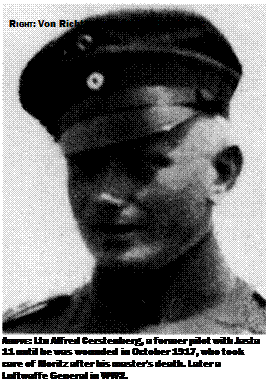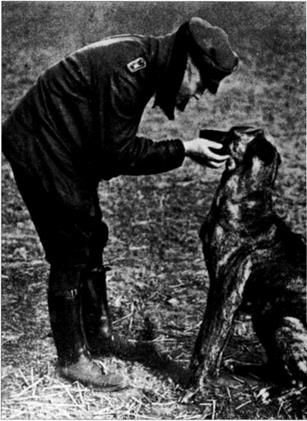The Third Medical Examination
(The Extra One)
During the Germans March Offensive, and the Allied effort which stopped the Germans from taking Amiens, there had been a scandalous shortage of bandages, dressings and medication in the Field Advanced Dressing Stations and the Main Dressing Stations. This was due, in great part, to the confusion of the retreat and the «к/ hoc measures taken to stem the German onslaught.
A renewal of the German attack was expected towards the end of April (it actually began on the 24th) and Colonel George W Barber, the Deputy Director of Medical Services, (the AlF’s top Medical Services man outside Australia), who was based at Villers Bocage just north of Amiens, was determined that, this time, the AIF men at least would lack for nothing in the way of immediate treatment.
Accordingly, in early April, he began a series of personal inspections of the advanced and the support medical facilities. On 21 April, accompanied by Major C L Chapman AAMC. he inspected the 12th Australian Field Ambulance unit. On the morning of the 22nd he went to Bertangles where he (quote): ‘Conferred with the Officer Commanding |the| 3rd Australian Flying Squadron re his medical requirements.’The officer would have most probably been Major Blake whose aeroplanes were at nearby Poulainville aerodrome.
Upon arrival he learned that Baron von Richthofen s body was at the aerodrome lying in a 3 Squadron tent hangar at Poulainville. His programme for later that morning, to inspect 3 FC‘s Dressing Station, thereupon suffered a short postponement. It was too good an opportunity to allow to pass by.
Colonel Barber and Major Chapman arrived at the tent hangar just as the medical orderlies were cleaning up after the examination by Colonels Sinclair and Nixon. The story of what happened next is best described in Barbers own words in a letter to С E W Bean 1’A years later:
October 23rd, 1935
My Dear Bean,
With reference to your letter of Oct.
14th, I was Inspecting this Air Force
unit and found the medical orderly
washing Richthofen’s body, so I made an examination. There were only two bullet wounds, one of entry and one of exit of a bullet which had evidently passed through the chest and the heart. There was NO WOUND of the head but there was considerable bruising over the right jaw which may have been fractured. The orderly told me that the Consulting Surgeon of the army [the Fourth Army] had made a post mortem that morning. I asked him how he did it as there was no evidence. The orderly told me that the Consulting Surgeon had used a bit of fencing wire which he pushed along the track of the wound over the heart. I used the same bit of wire for the same purpose. So you see the medical examination was not a thorough one and not a post mortem in the ordinary sense of the term. A bullet hole in the side of the plane coincided with the wound through the chest and I am sure he was shot from below while banking. I sent a full report to General Birdwood at Australian Corps and I have often wondered what became of it.
With kind regards. Yours sincerely, George W Barber
P. S. Of course a proper PM might have been made after I saw the body but I never heard of it and do not think so.
In a letter to a British Military Publication circa 1930, Major General Barber supplied information identical to that given above but with one addition:
The report that it [the body] was riddled with bullets is absolutely incorrect. There was one bullet wound only and this was through the man’s chest. I formed the opinion that it had been fired from the ground and struck the airman as he was banking his machine, because the exit of the bullet was three inches higher than the point of entry.
Whatever written contribution Major Chapman made for posterity is also now lost except for a quotation: ‘The bullet came out about three inches higher than it went in and might well have been shot from the ground.’
Because Colonel Barber’s written report appears lost, and without secure knowledge of what was in it, beyond the affirmation that only one bullet had struck the body and that the other so-called wounds were all impact injuries, there are no known actions of his which can be taken as first hand discoveries. His major contribution was ordering Corporal Ted McCarty, the medical orderly, to undress the body completely and thereby setting beyond doubt that there were no other bullet wounds anywhere on it.
It is obvious from the content of Barber’s letter that he had received information from others on the circumstances of the Red Devil’s demise, not the least of which was the bullet hole in the fuselage, which he may or may not have been shown but was obviously told about. Corporal McCarty certainly had watched what Colonel Sinclair had been doing because he knew of the piece of wire and because in later years he mentioned that the bullet had dog-legged inside von Richthofen’s body. It must have been common knowledge amongst all the orderlies that the Fourth Army Consulting Surgeon had said so, and he would carry much more weight with them than the new 22 Wing MO. McCarty still remained quiet about the bullet which he had found in the clothing. One has to wonder about this all the time. If he had been an ordinary‘erk’ one might excuse it, but being a medical orderly he must have known of its possible importance. He was apparently not looking for any trouble that might arise, and the longer he remained quiet the more he would be unable to admit to his find. Initially he had told others there were at least three bullet holes in the body, so perhaps finding just one bullet didn’t seem overly important at the beginning. Or perhaps it was purely a case of having a great souvenir and he was going to keep it!
It could be said that Colonel Barbers letter agrees with Graham and Downs in that the shot came from roughly in the plane of the long axis, although he goes a little further than they did by indirectly pointing out that said axis might well have been inclined at the time. On another point he appears to agree with Sinclair and Nixon for, although there is no record that Colonel Barber’s probing confirmed Sinclair’s conclusions, there are no reports or rumours that he disagreed with them. Not even amongst the post-war recollections of the orderlies.
That afternoon, von Richthofen’s body was interred with full military honours. The pallbearers were pilots from 3 AFC Squadron, one of them being Lieutenant Banks. The next day, RAF aeroplanes dropped photographs of the grave at useful locations over the German lines. One of the pilots selected was Lieutenant Robert Foster of 209 Squadron.
Back at Сарру, with the realisation that von Richthofen was not coming back. JGIs adjutant, Oberleutnant Karl Bodenschatz, opened a box kept in the office safe, in which he knew there was an envelope for just such an occasion as this. He opened it. There was a single pencil-written sentence, dated 10 March 1918 – just about six weeks earlier:
Solte ich nicht zuriick kommen. so Obit. Reinhard (Jasta 6) die FCihrung des Luftgeschwaders Giber nehman.
Freiherr v Ri chthofen Ri ttmei ster
(Should I not return. Oberleutnant Reinhard (Jasta 6) is to assume command of the Geschwader.)
The Baron’s obituary in Flight magazine was short and elegant: ‘Manfred von Richthofen is dead. He was a brave man, a clean fighter and an aristocrat. May he rest in peace.’
Oberleutnant Wilhelm (Willi) Reinhard led JGI until 18 June 1918. On that date he handed over temporary command to Erich Lowenhardt in order to go to Adlershof, Berlin, to attend a flight test programme of the latest aeroplane designs. The aces were the test pilots and each one flew an aeroplane in mock combat with the others. On 3 July Oberleutnant Hermann Goring landed the Dornier DI, an all-metal framed biplane, and handed it over to Reinhard. During his flight in it, the top wing collapsed and Reinhard was killed in the crash. Thus was altered the course of history. Goring, the Staffelflihrer of Jasta 27, was promoted to lead Richthofen’s JGI three days later, and after the war became Prime Minister of East Prussia, then finally Reichsmarschall. head of the German Luftwaffe, and in September 1939 Adolf Hitler’s designated successor.
Von Richthofen’s dog Moritz was adopted by Leutnant Alfred Gerstenberg, a former pilot in Jasta 11, who took him home to his farm. Many years later Moritz died there of old age. Gerstenberg became a Generalleutnant in the Luftwaffe in WW2 and died in 1959.
 |
 |
The Basic Facts ofVon
Richthofen’s Fatal Wound
1. It was inflicted by a Spitzer-type rifle bullet either fired by a machine gun or a rifle and travelled far enough through the Barons body to begin tumbling. This created a large exit wound but not so large as others which Captain Graham had seen.
2. The general direction of the bullet path through von Richthofens body was upwards. The exit wound (between the 5th and 6th ribs on the left side) was more than two inches higher than the entry wound (through the ninth rib on the right side).
3. The trajectory of the bullet in the vertical plane was slightly upwards relative to the side panels of the fuselage of the Triplane.
4. The trajectory of the bullet in the horizontal plane relative to the side panels of the fuselage was the subject of dispute.
come from slightly behind. Lieutenant Downs did not oppose Graham s opinion although earlier he had expressed doubts.
Colonel Nixon and Colonel Sinclair, after checking the initial permanent cavity direction, decided that the bullet had come from slightly in front.
5. Captain Graham gave the opinion that the bullet had passed in a straight line from entry to exit. Again Lieutenant Downs did not oppose Graham’s opinion, although as before he had doubts.
6. Colonels Nixon and Sinclair, after checking the permanent cavity, stated that the bullet had doglegged inside the body having been deflected off the front of the spine.
7. Colonel Barbers examination report has been lost – or at least not found. In a letter on the subject he affirmed that von Richthofen had been shot from the right. (See Chapter 14)
Captain Graham, 22 Wing Medical Officer, who did not actually check the initial permanent cavity direction, gave an opinion that the bullet had










